The best hybrid SUVs – PHEVs and regular hybrids rated
We pick the very finest hybrid SUVs on the road, with compact, family and luxury models all making the cut
News


by Jack Warrick and Murray Scullion
9 mins read
16 April 2025
Share
Looking for a practical SUV that balances power, efficiency and eco-conscious driving? If so, a hybrid is the smart choice.
In a market divided between petrol and electric, hybrid SUVs deliver a winning mix of both.
At their best, they offer some of the fuel savings associated with an electric car teamed with the steadfastness of a combustion engine.
Related articles
- The best large SUVs – driven, rated and ranked
- The best small SUVs – driven, tested and ranked
- The best sports cars – driven, rated and ranked
- The best MPVs and people carriers – driven and tested
- Best hot hatches – driven, rated and ranked
They’re also a hit with company car drivers, thanks to lower benefit-in-kind tax rates, making them a savvy financial pick too.
This list comprises of regular hybrid and plug-in hybrid SUVs.
PHEV tech works especially well in SUVs, where there’s space to fit batteries and motors without sacrificing too much practicality or comfort. Regular hybrid SUVs are less economical but are typically cheaper to buy and don’t need to be plugged in.
Topping our list is the Skoda Kodiaq PHEV. Our testers were impressed with its comfort, practicality and its 71 miles of electric-only range.
Keep reading to dive into our top picks and we will help find the right hybrid SUV for you.
1. Skoda Kodiaq
9
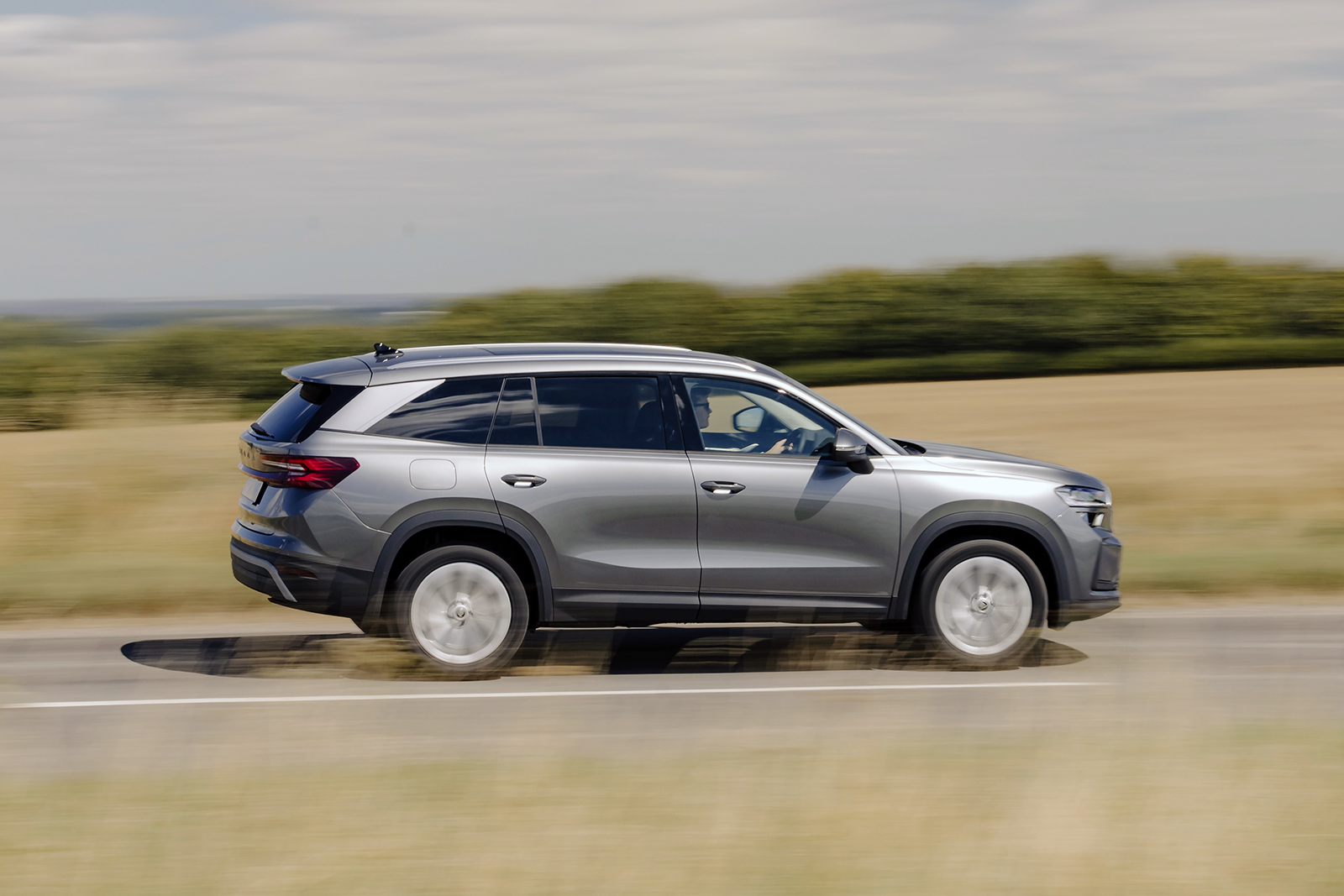
- Design8
- Interior9
- Performance8
- Ride & Handling8
- Costs9
Pros
Very roomy and practical
PHEV offers unrivalled electric range
Control are well-resolved
Cons
Doesn’t ride as well as it should
Auto gearbox indecisive at low speed
Too many models
Best for: All-round ability
The Volkswagen Tiguan, Volkswagen Passat, Skoda Superb and Skoda Kodiaq all share the same platform and powertrains, but it’s the Kodiaq that really stands out to us.
The Kodiaq is seriously hard to fault.
The PHEV version’s impressive 71-mile (WLTP) electric range puts head and shoulders above most other PHEVs in its class, while its tall, practical design makes it a family-friendly powerhouse.
The middle row is so spacious that it rivals the Mercedes S-Class limo for leg room.
The boot is massive too, offering 745 litres worth of space.
There is a catch, though: there’s no seven-seat option for the PHEV. That’s exclusive to the regular ICE models.
Read our Skoda Kodiaq review
Save money on a new Skoda Kodiaq with What Car?
Finance this car with Drivenfi
Latest Reviews

Mercedes-AMG CLE 53
8

Volkswagen Tiguan
7

Honda Civic Type R
9

Used BMW 3 Series Touring 2012-2019 review
9
Used BMW 3 Series Touring 2012-2019 review

Aston Martin Vantage Roadster
Read our review
Car review

Mercedes GLC
Medium-sized SUV, the sales star of the Mercedes range, is re-engineered to stay fighting fit
Back to top
2. Mercedes-Benz GLC
9
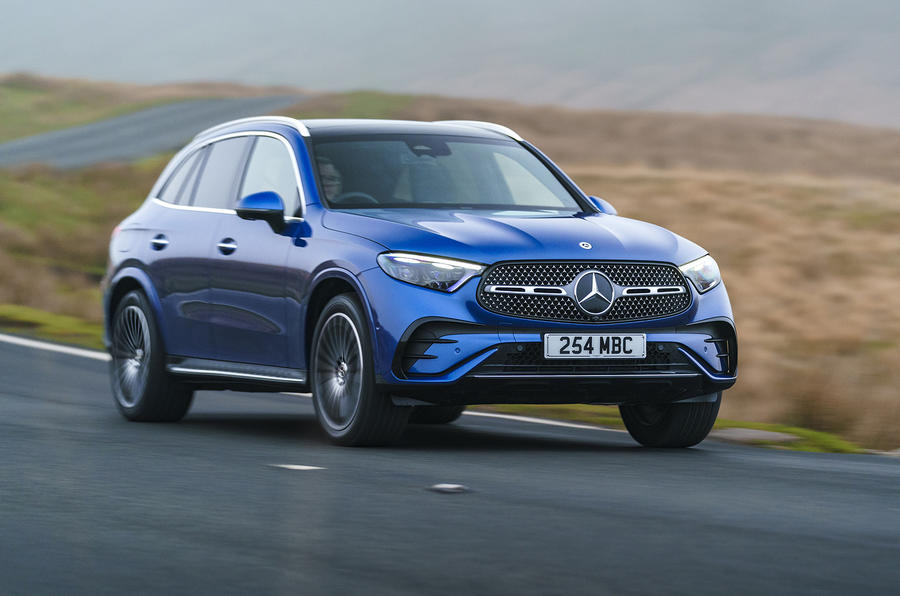
- Design8
- Interior9
- Performance8
- Ride & Handling8
- Costs7
Pros
Exceptional electric-only range
Impressive digital cabin technology
Lots of luxury cabin feel
Cons
Rides like a heavy SUV
Expensive
Ride comfort isn’t unremarkable
Best for: EV range with a posh interior
If it’s the potential for lots of electric-only running that attracts you to the idea of a hybrid SUV – whether that’s for what it saves you at the petrol pump or on your annual P11D form – one contender currently stands out clearly from the field: the Mercedes GLC 300e.
The GLC makes the BMW X3 feel a little ordinary and the Audi Q5 a touch joyless.
Mercedes fitted a whacking great 31.2kWh drive battery to this car for its second-generation version. That would have been unusually large for a full-size luxury SUV, let alone a mid-sized one. It makes the GLC 300e good for a claimed 83 miles of tax-qualifying electric range – and one of few cars on this list that will get you a 5% BIK qualification even if you lavish plenty of options on it.
The snag is, however, that even base-spec models cost around £65,000. But it is a modern Mercedes SUV, which means it’s not short of digital multimedia technology or luxury cabin feel.
The GLC 300e is driven by a 2.0-litre four-cylinder turbocharged petrol engine working in tandem with a 134bhp electric drive motor. Weighing almost 2.3 tonnes, it’s not the most dynamic drive in this list and struggles a little with vertical body control on country roads. But it’s smooth and quiet whether running electrically or not; has decent electric-only oomph to match that electric range; and doesn’t penalise owners with reduced boot volume either.
Read our Mercedes-Benz GLC review
Save money on a new Mercedes-Benz GLC with What Car?
Finance this car with Drivenfi
3. BMW X5
9
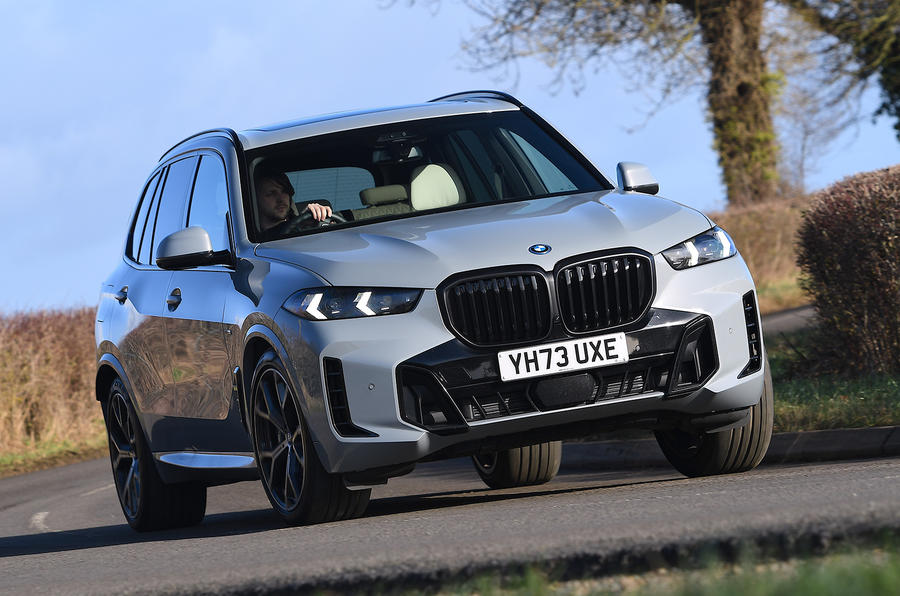
- Design8
- Interior8
- Performance9
- Ride & Handling8
- Costs6
Pros
Ride and handles really well
Plenty of real-world electric range
Smooth and powerful straight six
Cons
No seven-seat option
PHEV trades a little cargo space
Expensive
Best for: Performance
The star attraction of the X5 xDrive50e is its creamy-smooth 3.0-litre straight six, which works in tandem with an electric motor to give both a startling turn of speed and surprisingly low running costs.
PHEV sensibilities mix well with driver involvement here.
Given its head, this combination musters an impressive 485bhp and the electric motor has enough urge to make the car feel brisk enough while mooching around.
Speaking of which, thanks to a 25.7kWh battery, this X5 can travel on pure electricity for up to 66 miles, which is both nifty and allows it to qualify for 8% BIK tax.
In spite of the increase in kerb weight (this BMW causes the scales to creak under strain of 2495kg), it drives as well as any X5 there has ever been and, for those who don’t know, that’s a high dynamic marker for a large SUV. It’s polished, slick and refined, but also controls its mass well and handles neatly and with compelling poise for a big car.
Inside, cabin quality is good enough to compete with anything else on this list, and practicality is strong even though the packaging of the PHEV drive battery robs the car of its third row of seating and a little of its cargo capacity.
Read our BMW X5 review
Save money on a new BMW X5 with What Car?
Finance this car with Drivenfi
Back to top
4. Hyundai Santa Fe
8
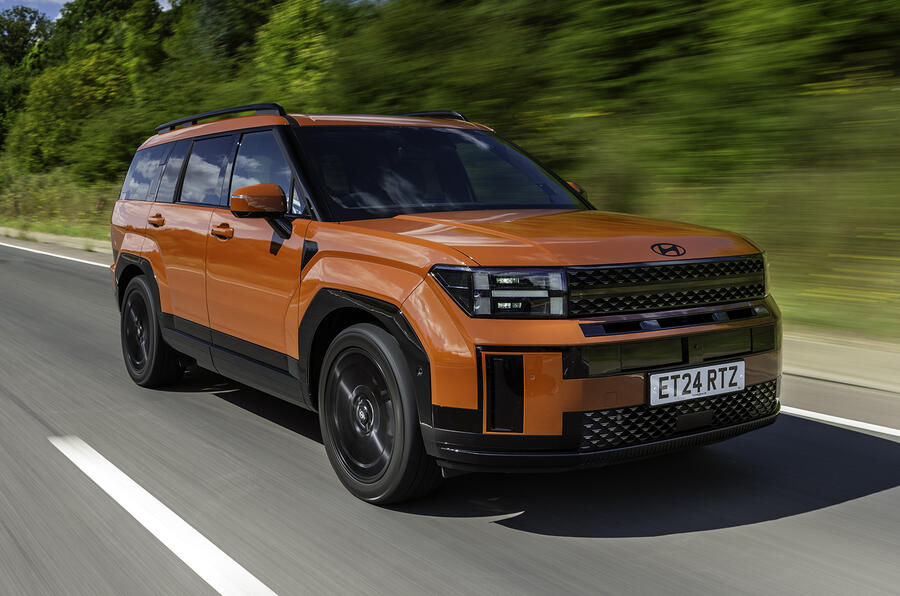
- Design9
- Interior8
- Performance7
- Ride & Handling7
- Costs8
Pros
Huge amounts of space
Plush and comfortable interior
Up to seven seats
Cons
Love-it-or-hate-it design
Heavy
Engine is gruff when it kicks in
Best for: Space
The Santa Fe offers standout looks (love them or hate them), a huge amount of space, seven seats and a genuinely plush interior.
Sensible hybrid power meets stand-out design here.
The range opens with a 1.6-litre hybrid powertrain, which uses a turbocharged petrol engine supported by an electric motor. Total power stands at 212bhp and 270lb ft, and it’s nice to drive, with all-electric power available in town.
Hyundai’s seven-seater also offers a PHEV powertrain, which uses the same 1.6-litre turbocharged engine but with a 13.8kWh battery and a 96bhp electric motor. With 249bhp, it does a great job of shifting the heavy Santa Fe with a welcome degree of quietness and refinement.
Its 0-62mph sprint takes just 9.3sec, which is competitive, although it is slightly let down by its 33-mile electric-only range, which is behind much of the competition.
Overall, though, the Santa Fe is a great hybrid SUV and should definitely be considered by those seeking a larger-than-average model.
Read our Hyundai Santa Fe review
Save money on a new Hyundai Santa Fe with What Car?
Finance this car with Drivenfi
5. Kia Sportage
8

- Design7
- Interior7
- Performance8
- Ride & Handling8
- Costs8
Pros
Great value
Looks distinctive
Impressive cabin quality
Cons
Ride and handling are just okay
Not as spacious as others
Coarse engine at higher speeds
Best for: Versatility
For a PHEV to be really tax-efficient, it must offer a blend of electric range and value – which is precisely what the Kia Sportage PHEV does.
The trim to go for is 3, as it comes with heated seats and digital instruments.
You will have to look long and hard for a family car that is as practical as this; that has more than 40 miles of lab-test-certified electric range and so qualifies for 8% BIK; and that can be snapped up for little more than £40,000.
It’s a fairly compact SUV but offers adult-appropriate passenger accommodation in both rows of seats and a robust and high-quality cabin.
It can be bought with a 48V mild-hybrid powertrain; as a full hybrid (HEV) with only limited electric range and no plug; and as a 1.6-litre PHEV with a certified 42 miles of electric range.
The PHEV has the most power and also better performance and drivability than the cheaper HEV.
The Sportage’s slightly anodyne handling is unlikely to excite you, but its styling remains really distinctive and its ownership credentials are clear.
Read our Kia Sportage review
Save money on a new Kia Sportage with What Car?
Finance this car with Drivenfi
Back to top
6. Range Rover Sport
8

- Design9
- Interior9
- Performance8
- Ride & Handling8
- Costs6
Pros
Smooth six-cylinder petrol engine
Enticingly luxurious cabin and ride
Low BIK tax
Cons
High starting price
Spend too much on options and you can end up in wrong BIK tax bracket
Very big
Best for: Luxury
Now in its third generation, the most dynamic of all Range Rover models is, unsurprisingly, the best Sport yet.
The car earns particular credit for its excellent mechanical refinement and smooth drivability.
At the heart of the car’s appeal is JLR’s latest PHEV drivetrain, which combines a lusty 3.0-litre turbo petrol straight six with a gearbox-mounted electric motor and very generous 38.2kWh battery.
The result is an impressive electric-only range of up to 74 miles. So provided you don’t put too many heavy options or big alloy wheels on your car, this is one of the few SUVs in our top 10 to give you access to 5% BIK tax.
For cosseting luxury, no car on this list can match the Range Rover Sport, its spacious and opulent interior dripping in rich materials and the sort of slick tech that adds plenty of showroom appeal.
On the move, it’s nearly as quiet and comfy as the full-size Range Rover, but the addition of four-wheel steering and active anti-roll adds an extra dimension of agility and driver engagement.
It’s not cheap, but the best things in life rarely are. A shoo-in for pride of place in the directors’ car park, then.
Read our Range Rover Sport review
Save money on a new Range Rover Sport with What Car?
Finance this car with Drivenfi
7. Porsche Cayenne
8
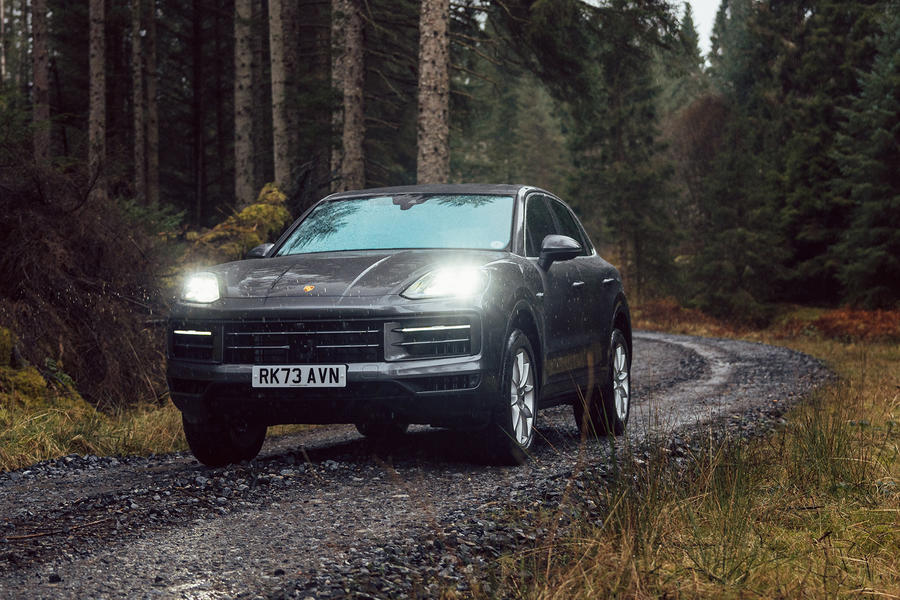
- Design7
- Interior8
- Performance9
- Ride & Handling8
- Costs6
Pros
High performance yet low BIK tax
Cabin richness
Digital tech
Cons
Pricing you would expect for a big Porsche
Not quite as refined as some rivals
Heavy
Best for: Driver appeal
The Porsche Cayenne remains the segment’s defining performance SUV. It has always offered knockout performance powertrains, of course, but in this latest, facelifted, third-generation version, it puts at least as much emphasis on tax-savvy PHEV power, in order to keep the car relevant as the high-powered business executive’s status SUV of choice.
The V6 makes more sense on paper. But should you buy a Porsche on paper?
Between the E-Hybrid, S E-Hybrid and Turbo E-Hybrid versions, there are now three PHEV models to choose from – and, while none quite competes with rivals for the longest electric range on this list, all qualify for 8% BIK tax.
The two lesser models combine V6 turbo petrol engines with their electric motors, with the S E-Hybrid making a little over 500bhp and managing 0-62mph in a little under 5.0sec. The Turbo E-Hybrid is one of few V8 hybrid PHEVs on the market, offering in excess of 700bhp, 0-62mph in just 3.7sec and a top speed of more than 180mph.
Bristling with driver appeal and with a refreshed interior packed with material quality and digital technology, there’s no other PHEV quite like this – and few that justify a high price in such clear and direct sporting terms.
Read our Porsche Cayenne review
Save money on a new Porsche Cayenne with What Car?
Finance this car with Drivenfi
Back to top
8. BMW X1
7
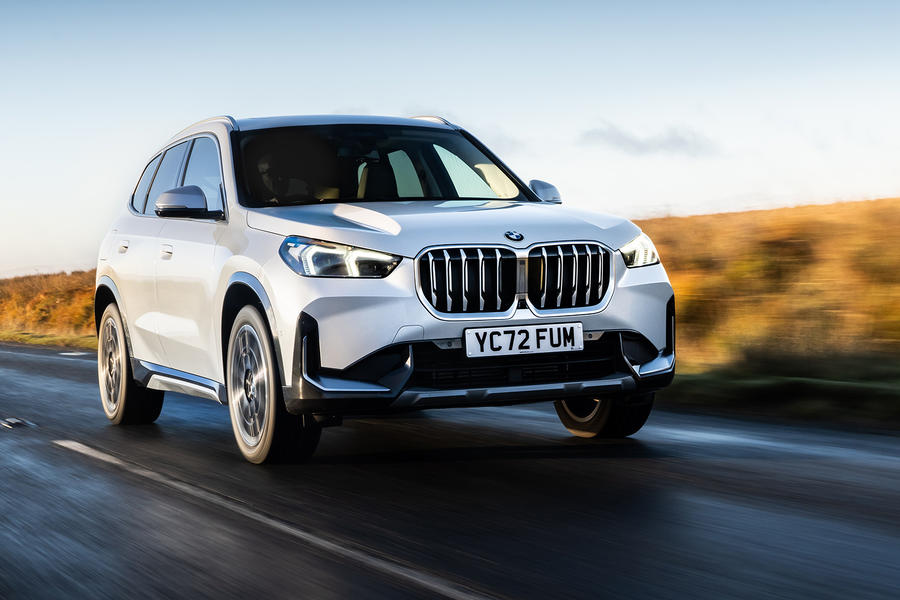
- Design7
- Interior8
- Performance7
- Ride & Handling7
- Costs7
Pros
Electric range of more than 50 miles
Well packaged
Desirable
Cons
Slightly distracting screen
Larger cars available for similar money
Clunky automatic gearbox
Best for: Affordable luxury
BMW’s second entry in this top 10 illustrates how quickly hybrid technology is improving. Three years ago, only a handful of electrified mid-sized SUVs were rated for more than 40 miles of electric running and most of those were priced at a premium, even when sold by non-premium brands.
Class-leading boot space and rear leg room make it a sensible buy for a small-ish family.
Today, however, even with the rampant inflation we’ve seen since then, you can pay less than £45k for a mid-sized SUV rated for more than 50 miles of electric range, provided you know where to look.
The BMW X1 is where. It’s offered with two PHEV powertrains in addition to cheaper pure-ICE powertrains: the X1 xDrive25e and xDrive30e.
Both use 1.5-litre three-cylinder turbo petrol engines for the front axle, and electric drive motors over their rear ones; both can be equipped just so for a little over 50 miles of electric range; and while the 25e offers 242bhp of total system power, the 30e increases that to 321bhp.
The X1 has an especially spacious cabin for a mid-sized SUV and handles with plenty of grip and precision, although its multimedia usability isn’t great. But it is one of the smarter ways to get lots of electric running in a smaller and more affordable package.
Read our BMW X1 review
Save money on a new BMW X1 with What Car?
Finance this car with Drivenfi
9. Lexus NX
7
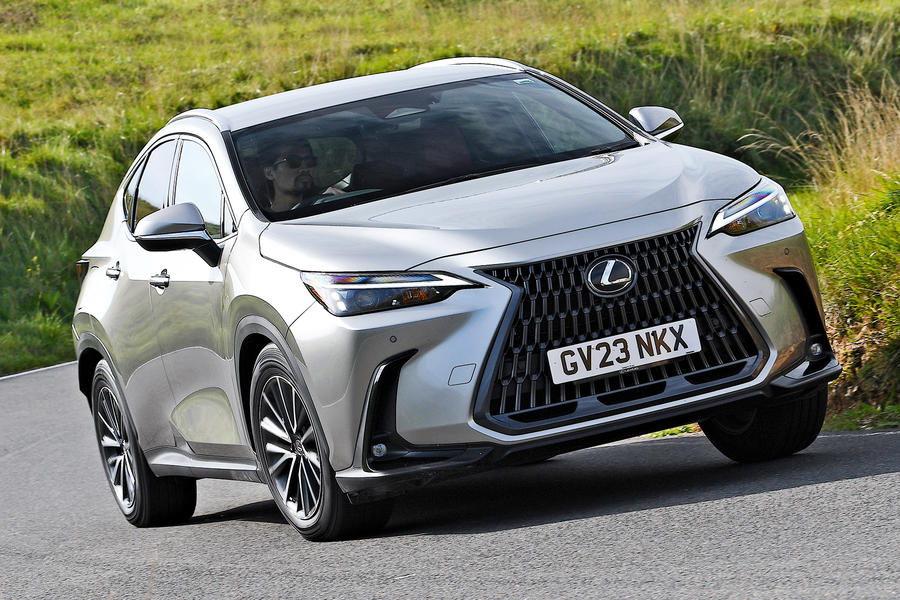
- Design8
- Interior8
- Performance6
- Ride & Handling6
- Costs7
Pros
Refined and luxurious
Some smart digital features
Long warranty
Cons
Hybrid system isn’t a natural entertainer
Not as spacious as some for the money
Engine drones loudly at idle
Best for: Reliability
Refinement feels like it should be a natural quality for a hybrid SUV, but few of them offer as much of it as the Lexus NX. Lexus has been making electrified SUVs for longer than most car companies, of course, but it’s the company’s habitual focus on filtering out the outside world and lavishing fine attention to detail on producing a really relaxing driving experience that shine through in the NX.
The combination of its sumptuous interior and quietly assured drivability makes it a pleasure to rub along with day to day.
This is a mid-sized, five-seat SUV designed to compete with anything from the Range Rover Evoque to the BMW X3. Available with a choice of electrified powertrains – as a 350h ‘self-charging’ four-cylinder hybrid or a 450h+ PHEV – it doesn’t railroad private buyers into living with a PHEV option that may not suit them.
If you go for the pricier PHEV, you will get a car rated for 45 miles of electric range. But if you can’t charge it and don’t pay company car tax anyway, you could have the regular hybrid instead, save a few quid and know that you’re not lugging around so many kWh of battery ballast that isn’t really useful to you.
Lexus’s familiar hybrid drive system makes for a slightly distant-feeling driving experience but it doesn’t want for outright performance, while the handling of F-Sport versions, on adaptive dampers, is neat, tidy and precise.
Read our Lexus NX review
Save money on a new Lexus NX with What Car?
Finance this car with Drivenfi
Back to top
10. MG ZS
7
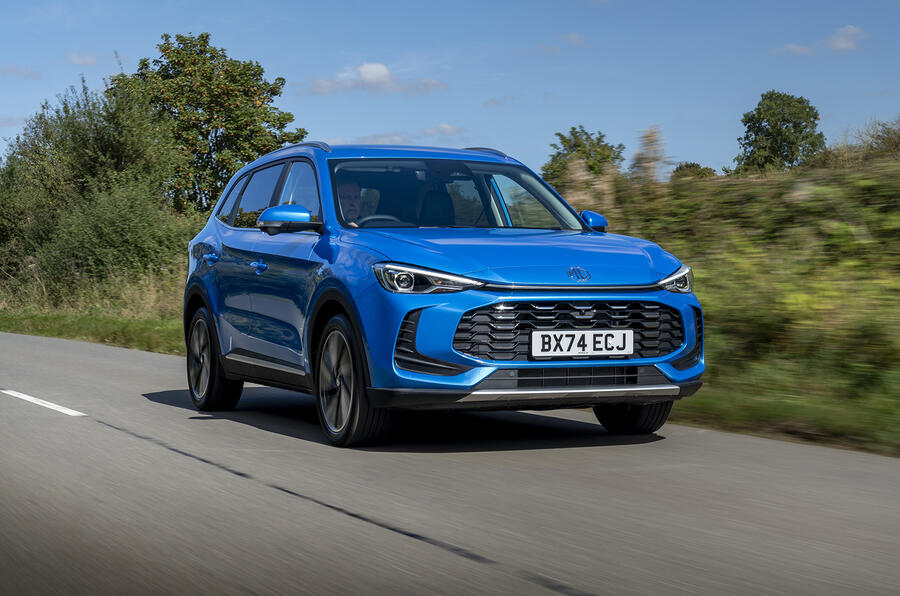
- Design6
- Interior6
- Performance7
- Ride & Handling6
- Costs9
Pros
Great value for money
Good performance
Spacious
Cons
Not as good to drive as many other alternatives
Some cheap interior materials
Annoying ADAS system
Best for: Value
MG’s popular compact SUV is powered by a 1.5-litre petrol engine with hybrid assistance. It offers 195bhp – the same as in the MG 3 hybrid supermini – and is managed by a three-speed automatic gearbox.
The ZS is roomier, cleverer and better-equipped than you would expect for the money.
Among the ZS’s headline attractions are its starting price and value for money. It starts from less than £20,000, making it one of the cheapest hybrids you can buy today.
That said, it’s not nearly as good to drive as the other SUVs in this list, but it’s well equipped compared with many – especially at that price point.




